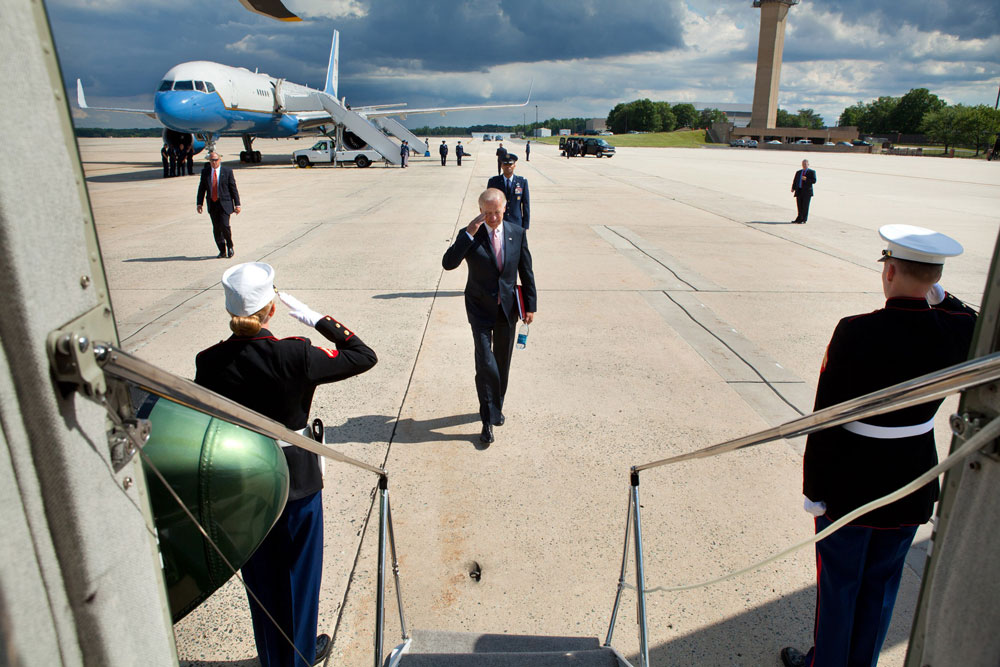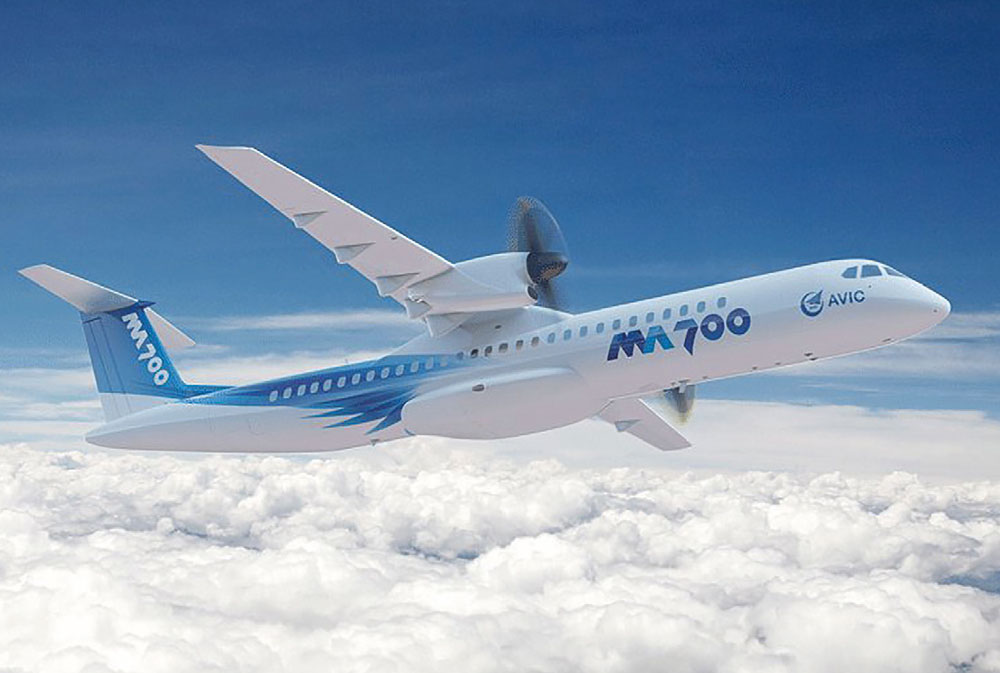AEROSPACE US President and China
Can President Biden reset relations with China?
With the change of leadership in the US, RICHARD ABOULAFIA FRAeS considers one of the biggest policy challenges waiting in President Joe Biden’s inbox.
 Then Vice President Joe Biden salutes as he approaches Marine Two,
with Air Force Two in the background, after landing at Joint Base Andrews in 2012. David Lienemann
Then Vice President Joe Biden salutes as he approaches Marine Two,
with Air Force Two in the background, after landing at Joint Base Andrews in 2012. David Lienemann
In December, the Trump administration announced that it would create a new ‘military end user’ list impacting trade with over 100 Chinese and Russian companies and entities. For the aviation industry, the upshot is that the new list could make all of the technology transfer and sourcing arrangements between Chinese airframers and Western companies impossible, or at least extremely difficult. Thus, all of China’s aircraft programmes, as currently configured, might be over.
This move happened surprisingly late in the Trump presidency. His administration’s approach towards trade with China had been aggressive and deliberately aimed at destroying the existing status quo. Like a lot of other Trump-era trade rules, it came with a host of possible loopholes, uncertainties and a general lack of clarity.
For example, the Commercial Aircraft Corporation of China (COMAC) is not on the list but all the Aviation Industry Corporation of China (AVIC) companies are, and AVIC is a key owner of COMAC. COMAC’s products are effectively (but not definitely) AVIC products and no clarity has been provided on this by the agencies responsible for the list.
Since the new list was announced by the Department of Commerce in the last few weeks of the Trump presidency, it could be reversed by the Biden administration, which will need to deal with this list as a high-priority problem either way. Since both candidates campaigned on a promise to be ‘tough on China,’ revoking the new list might be politically difficult.
Closing shop
From a Chinese perspective, the US move reveals some difficult truths about the country’s aviation strategy. China’s priority has been creating national aircraft, with all the necessary engines, avionics, systems and other technologies all imported. These imports are accompanied by extensive technology transfer schemes but the scale of replicating an entire aviation supply chain in-country would seem beyond any country’s reach. No country has achieved this level of self-sufficiency, with the possible exception of the old Soviet Union.
WHILE THE AVIATION TRADE BALANCE BETWEEN THE US AND CHINA WAS STRONGLY IN THE US’ FAVOUR, AVIATION WAS REALLY THE ONLY MAJOR MANUFACTURING INDUSTRY WHERE THIS WAS TRUE
To put it another way, building a tube and wings with a national flag on the back is easy. Building the guts to make an aeroplane work, and to make it competitive and productive, is far harder and far more expensive. This supply chain replication challenge has much in common with China’s semiconductor creation initiatives, which appear to be failing too.
From a US perspective, however, this list, and the trade strategy behind it, does have some appeal. For years, the PRC viewed Western aerospace industries as a source of technology, to be obtained legally and illicitly. In addition to technology transfer demands, China’s government and industry have demonstrated a lack of respect for intellectual property rights and have also been accused of extensive cybertheft of aerospace technology too.
While the aviation trade balance between the US and China was strongly in the US’ favour, aviation was really the only major manufacturing industry where this was true and with its new platforms, China was even trying to remove this advantage, effectively making trade relations less appealing from a US perspective.
So, for the US at least, the new strategy gives the US a degree of agency with regard to aviation. Western aerospace is no longer just the designated hostage in any trade stand-off with the West, as one former chief executive put it. The new list tells the Chinese government that now, China too has something to lose. Its cherished national platforms will be completely useless without these imported technologies, and will remain useless for at least another decade until China can create substitutes (assuming that it can).
 Western suppliers on China’s Xian MA700 regional turboprop include Collins Aerospace, Dowty Propellers, Pratt & Whitney Canada, Thales, Meggitt, Honeywell, Eaton and Parker Hannifin. Collins Aerospace
Western suppliers on China’s Xian MA700 regional turboprop include Collins Aerospace, Dowty Propellers, Pratt & Whitney Canada, Thales, Meggitt, Honeywell, Eaton and Parker Hannifin. Collins Aerospace
Trade or no trade?
If the Biden administration does indeed continue Trump’s initiative to stop any kind of aviation technology trade, there are three possible outcomes to this situation:
- US victory. In this rather happy, if unlikely, scenario, the PRC admits that its aviation industry strategy has been flawed. They resume sourcing jets from the West and even agree to respect the World Trade Organization Agreement on Trade In Civil Aircraft, which forbids government-mandated purchases of national aircraft. Most importantly, they agree to respect intellectual property rights and to maintain strict firewalls between civil and military applications for aviation technology, to the extent that this is possible. As for China’s aerospace industry strategy, national aircraft development would continue but the real emphasis would be on joining the global aviation supply chain, emulating Japan’s supplier-focused approach.
- Chinese strategic patience. Here, China would agree to a few concessions – perhaps a well-orchestrated purchase of Boeing jets, and a promise of greater intellectual property respect – in exchange for removing China’s aviation companies from the ‘military end user’ list. In the long run, China would bolster its indigenous capabilities, continuing both its national aircraft programmes and also its systems and component technologies. It would take a long view, preparing for a decoupled future where China’s industry could meet domestic market needs with autarkic products.
- Aggressive decoupling, with a shift towards Russia. In this scenario, the PRC would react to the US move by announcing the effective end of China-Western aviation co-operation. The country would embark on a crash programme to create indigenous substitutes for the Western equipment on the ARJ21, C919 and the future CR929. Co-operation with Russian industry would help to accelerate this process, albeit at the price of tying China’s aviation future to a much less competitive level of commercial technology. Purchases and financing of Western jets by Chinese institutions would be kept to a minimum, even if national aviation market growth slowed as a consequence.
While this third option might seem drastic, the possibility should be seen in a broader context. The PRC, over the past few years, has engaged in a counterproductive shift away from the private sector and global trade and towards a government-managed economy emphasising state-owned enterprises. In recent months, this trend has grown to embrace a vilification of China’s own successful tech companies.
The path China takes may not be clear for months, or years, and the three possibilities might not be exclusive. They will also not be immutable.
The Biden administration’s approach might not be clear for months either. Hopefully, Biden’s team will recognise that the US’s go-it-alone approach to confronting China in aerospace, in general trade issues and even geopolitically, was terminally flawed. By working with allied countries, the US has the best chance of achieving a positive outcome.
 Then Vice President Joe Biden salutes as he approaches Marine Two,
with Air Force Two in the background, after landing at Joint Base Andrews in 2012. David Lienemann
Then Vice President Joe Biden salutes as he approaches Marine Two,
with Air Force Two in the background, after landing at Joint Base Andrews in 2012. David Lienemann